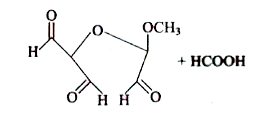What is the oxidation numbr of iodine in each of the following compounds: IF7,IF5,KI,I2,ICl,HIO4?
The correct Answer is:A
To find the oxidation number of iodine in each of the given compounds, we will apply the rules for determining oxidation states. Let's go through each compound step by step.
Step 1: Determine the oxidation number of iodine in IF₇
1. Let the oxidation number of iodine be X.
2. The oxidation number of fluorine (F) is always −1.
3. Since there are 7 fluorine atoms, the total contribution from fluorine is 7×(−1)=−7.
4. The compound is neutral, so the sum of oxidation numbers must equal 0:
X+(−7)=0
5. Solving for X:
X=+7
Step 2: Determine the oxidation number of iodine in IF₅
1. Let the oxidation number of iodine be X.
2. The oxidation number of fluorine is −1.
3. There are 5 fluorine atoms, contributing 5×(−1)=−5.
4. The compound is neutral:
X+(−5)=0
5. Solving for X:
X=+5
Step 3: Determine the oxidation number of iodine in KI
1. Let the oxidation number of iodine be X.
2. The oxidation number of potassium (K) is +1.
3. The compound is neutral:
+1+X=0
4. Solving for X:
X=−1
Step 4: Determine the oxidation number of iodine in I₂
1. Let the oxidation number of iodine be X.
2. As this is a diatomic molecule, the total oxidation number must equal 0:
2X=0
3. Solving for X:
X=0
Step 5: Determine the oxidation number of iodine in ICl
1. Let the oxidation number of iodine be X.
2. The oxidation number of chlorine (Cl) is −1.
3. The compound is neutral:
X+(−1)=0
4. Solving for X:
X=+1
Step 6: Determine the oxidation number of iodine in HIO₄
1. Let the oxidation number of iodine be X.
2. The oxidation number of hydrogen (H) is +1 and oxygen (O) is −2.
3. There are 4 oxygen atoms, contributing 4×(−2)=−8.
4. The compound is neutral:
+1+X+(−8)=0
5. Simplifying gives:
X−7=0⇒X=+7
Summary of Oxidation Numbers
- IF₇: +7
- IF₅: +5
- KI: -1
- I₂: 0
- ICl: +1
- HIO₄: +7
1. Let the oxidation number of iodine be X.
2. The oxidation number of fluorine (F) is always −1.
3. Since there are 7 fluorine atoms, the total contribution from fluorine is 7×(−1)=−7.
4. The compound is neutral, so the sum of oxidation numbers must equal 0:
X+(−7)=0
5. Solving for X:
X=+7
1. Let the oxidation number of iodine be X.
2. The oxidation number of fluorine is −1.
3. There are 5 fluorine atoms, contributing 5×(−1)=−5.
4. The compound is neutral:
X+(−5)=0
5. Solving for X:
X=+5
1. Let the oxidation number of iodine be X.
2. The oxidation number of potassium (K) is +1.
3. The compound is neutral:
+1+X=0
4. Solving for X:
X=−1
1. Let the oxidation number of iodine be X.
2. As this is a diatomic molecule, the total oxidation number must equal 0:
2X=0
3. Solving for X:
X=0
1. Let the oxidation number of iodine be X.
2. The oxidation number of chlorine (Cl) is −1.
3. The compound is neutral:
X+(−1)=0
4. Solving for X:
X=+1
1. Let the oxidation number of iodine be X.
2. The oxidation number of hydrogen (H) is +1 and oxygen (O) is −2.
3. There are 4 oxygen atoms, contributing 4×(−2)=−8.
4. The compound is neutral:
+1+X+(−8)=0
5. Simplifying gives:
X−7=0⇒X=+7
- IF₇: +7
- IF₅: +5
- KI: -1
- I₂: 0
- ICl: +1
- HIO₄: +7
Topper's Solved these Questions
- REDOX REACTIONSBOOK - CENGAGE CHEMISTRY ENGLISHCHAPTER - REDOX REACTIONSEXERCISE - Exercises (Linked Comprehension)
24 Videos
- REDOX REACTIONSBOOK - CENGAGE CHEMISTRY ENGLISHCHAPTER - REDOX REACTIONSEXERCISE - Exercises (Multiple Correct)
32 Videos
- REDOX REACTIONSBOOK - CENGAGE CHEMISTRY ENGLISHCHAPTER - REDOX REACTIONSEXERCISE - Ex 2.2
18 Videos
- PURIFICATION OF ORGANIC COMPOUNDS AND QUALITATIVE AND QUANTITATIVE ANALYSISBOOK - CENGAGE CHEMISTRY ENGLISHCHAPTER - PURIFICATION OF ORGANIC COMPOUNDS AND QUALITATIVE AND QUANTITATIVE ANALYSISEXERCISE - Assertion Reasoning Type
5 Videos
- S-BLOCK GROUP 1 - ALKALI METALSBOOK - CENGAGE CHEMISTRY ENGLISHCHAPTER - S-BLOCK GROUP 1 - ALKALI METALSEXERCISE - Archives Subjective
8 Videos
Similar Questions
Assign oxidation number to the underlined elements in each of the following species :
H4P––2O7
View Solution(A) For the molecule IF7
(i) Draw the structure of the molecule.
(ii) State the hybridization of the central atom.
(iii) State the geometry of the molecule.
(B) Give reactions and conditions required for the preparation of the following compounds :
(i) XeF6
(ii) XeOF4.
View Solution
Knowledge Check
The products of HIO4 oxidation of the following compound is :
 A
A B
B C
C D
D
What are the oxidation states of phosphorus in the following compounds ?
H3PO2,H3PO4,Mg2P2O7,PH3,HPO3A+1,+3,+3,+3,+5B+3,+3,+5,+5,+5C+1,+2,+3,+5,+5D+1,+5,+5,−3,+5
What is the product formed in each case when the following compounds react with H2O2?
(i) NaOH (ii) N2H4
View SolutionWhat are the oxidation numbers of the underlined elements in each of the following and how do you rationalize your result?
(a) KI3
(b) H2S4O6
(c)Fe3O4
(d) CH3CH2OH
(e)CH3COOH
View SolutionWhat is the product formed in each case when following compounds react with conc. H2SO4 ?
(i)KCl(ii)KBr(iii)NH3(iv)PCl5
View Solution(i) What are the types of hybridization of iodine in interhalogen compounds IF3,IF3 and IF7, respectively ?
(ii) Draw the structure of xenon hexafluoride (XeF6) molecule and state the hybridization of the central atom.
View SolutionDraw the Lewis dot structures of the following multicentred compounds:
I2O5,Cl2O7
View SolutionWrite three equivalent ratios for each of the following: 2:7 3:7 5:6 4:9
View Solution
